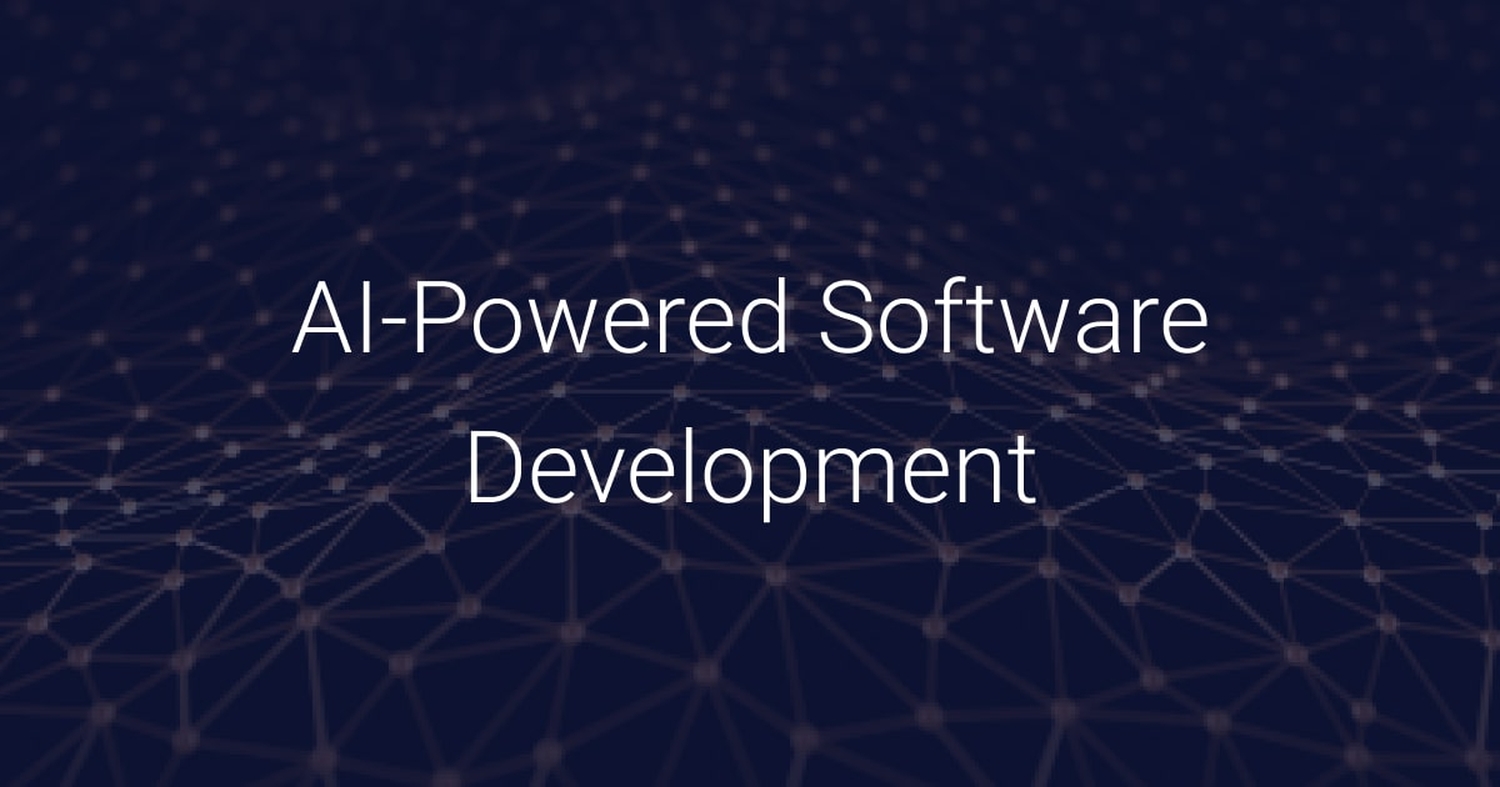
What’s one thing developers hate about coding? You’ll likely agree that it’s the painstaking process of debugging and troubleshooting to identify and fix errors or issues in their code. However, what if we told you there is a very promising solution to this problem? Well, yes, there is! As you guessed from the title of this article, the solution to this problem is AI-powered software development.
AI-powered software development tools can help address the challenge of debugging and troubleshooting. It can assist developers by automating error detection, suggesting fixes, and even predicting potential issues before they occur, which can significantly reduce the time and effort required for debugging tasks. This can lead to more efficient and error-free coding processes.
If you are eager to learn how AI-powered software development tools work or how you can start using these tools to transform your business or coding process, keep reading this article because you are about to find out! We also added a section at the end of this article that tells you how to build your software with a faster coding process.
Let's get started!
Outline
- What is AI-powered Software Development?
- AI’s Key Role in Software Development
- How to Use AI-powered Software Development Tools to Transform their Business
- Can AI be Used to Develop Software?
- Building Software With a Faster Coding Process
What is AI-powered Software Development?
AI-powered software development is a modern approach that leverages artificial intelligence technology to make the process of creating and improving software applications more efficient. This approach integrates AI algorithms and tools into the development workflow to assist developers in various ways.
One significant aspect of AI software development’s integration is code generation. AI can analyze project requirements and generate code templates or even complete code snippets, reducing the manual effort needed to write lines of code from scratch.
Another crucial role of AI in software development is debugging and error detection. AI-powered tools can automatically identify potential bugs in the code, making it easier for developers to catch and rectify issues before they become critical.
Additionally, AI assists in code optimization and refactoring. It can analyze existing codebases and suggest improvements to enhance performance, readability, and maintainability.
Here is an example to explain this approach better:
Imagine a team of developers working on an e-commerce website. They need to create a search feature that allows users to find products quickly. In the traditional development process, developers would need to write the code for searching and filtering products, which can be time-consuming and prone to errors.
However, with AI-powered software development, they can use a natural language processing (NLP) tool to describe the search feature they want in plain language. For instance, they could say, "I want a search bar that suggests products as users type and filters results based on categories." The AI then translates this description into code, generating the necessary HTML, CSS, and JavaScript code for the search feature.
As development progresses, AI-powered tools continuously analyze the code and automatically detect potential bugs or performance bottlenecks. If the AI identifies a bug, it can provide suggestions for fixing it. For example, the AI might recommend a more efficient approach if there's a problem with the search suggestion algorithm.
AI’s Key Role in Software Development
Artificial Intelligence (AI) and Machine Learning (ML) have ushered in a paradigm shift across the entire Software Development Life Cycle (SDLC), profoundly transforming its landscape and capabilities.
Today, software developers have at their disposal AI-powered tools that can not only write and review code but also meticulously detect bugs and aid in comprehensive software testing. This means that AI is not merely automating routine tasks but actively enhancing the quality and robustness of the software being developed.
One remarkable aspect is AI's role in code generation and review. AI algorithms, fueled by vast amounts of existing code and patterns, can now assist developers in crafting new code. This can significantly expedite the development process and ensure a certain level of code quality. Moreover, AI can serve as a "second pair of eyes" in code review, identifying potential pitfalls, suggesting optimizations, and adhering to best practices. This reduces the burden on developers and enhances the codebase's overall reliability and efficiency.
Another pivotal application of AI in the SDLC is bug detection. AI-powered tools can swiftly flag potential issues by analyzing code for anomalies and known bug patterns, allowing developers to rectify them proactively. This can save substantial time and resources that would otherwise be spent in extensive debugging phases. Aside from this, AI's ability to predict where bugs might occur based on patterns and historical data adds another layer of robustness to the software, ensuring a more seamless end-user experience.
Furthermore, AI contributes to software testing, a critical phase in the SDLC. AI-driven testing tools can simulate many user interactions and scenarios, covering much more ground than traditional testing methods. This results in more thorough testing and provides valuable insights into potential performance bottlenecks and areas for improvement.
In essence, AI is no longer just a supportive tool; it's becoming an indispensable partner in software development. Its ability to optimize workflows, reduce time-to-market, and enhance productivity makes it a game-changer for developers, paving the way for a new era of software development.
How to Use AI-powered Software Development Tools to Transform their Business
1. Understand Business Needs and Objectives:
How can you proffer a solution to a problem when you don’t fully understand the challenge? It’s almost impossible. Rather, you’ll find yourself moving in circles. It goes without saying that you can’t use AI-powered software development tools to improve your SDLC if you don’t even understand what your business hopes to achieve with such software.
This is why the first step to using AI-powered software development tools to transform your business is to conduct thorough discussions with stakeholders and subject matter experts within your business. For instance, if such a business is a healthcare company aiming to enhance patient engagement through a mobile application. You’ll need to engage with stakeholders to understand their objectives, such as improving user interface (UI) for intuitive navigation and implementing AI-powered features like appointment scheduling and medication reminders.
2. Choose AI Tools Relevant to the Objective:
Based on the identified objectives, your next step is to select AI-powered tools that align with the goal. For instance, using our example of the healthcare app, tools like Dialogflow by Google Cloud can be chosen for implementing a conversational interface for appointment scheduling. Dialogflow processes natural language and converts it into structured data, facilitating a seamless appointment-booking experience within the app.
3. Integrate AI Tools into the Development Workflow:
After this, ideally, you will want to integrate the chosen AI tool into the development workflow seamlessly. For instance, in the case of Dialogflow, developers can integrate it into the app's backend using APIs. They can set up intents and entities within Dialogflow to understand user requests related to appointment scheduling and connect this to the app's booking functionality.
4. Utilize AI for Code Optimization:
Next, incorporate AI-powered tools to optimize the codebase. For example, GitHub's Copilot can be integrated into the code editor. So when developers work on a feature like medication reminders, Copilot can provide code suggestions and snippets, making the coding process faster and more efficient.
5. Automate Bug Detection and Testing:
After code optimization, the next thing you want to do is to implement AI-powered tools for automating bug detection and testing. For this, we recommend tools like Selenium for automated testing of various app functionalities. This is because Selenium can learn from past tests and prioritize test cases based on potential impact when coupled with machine learning algorithms, enhancing overall test coverage.
6. Continuously Monitor and Optimize:
This step involves leveraging AI for continuous monitoring and optimization of the application. Here, you want to implement monitoring tools like New Relic, which uses AI to analyze real-time performance data and detect anomalies. For instance, going by our example of the medical app development, if the medication reminder feature experiences a performance drop, New Relic's AI can pinpoint the issue and suggest optimization strategies.
7. Gather Feedback and Iterate:
Gathering feedback and iterating is a pivotal phase in software development that involves systematically collecting input from users and stakeholders to refine and enhance the software. During this step, it's crucial to employ various feedback collection methods, such as surveys, user testing, and data analysis, to understand the software's performance and user experience comprehensively. The collected feedback is then carefully analyzed, categorized, and prioritized to identify areas for improvement, including bug fixes, feature enhancements, and usability refinements.
Still going by the healthcare app, in this stage, you could conduct beta testing with a selected group of users to gather feedback on the appointment scheduling and medication reminder features. You’ll also want to analyze the feedback, identify areas for improvement, and iterate on the app, refining the AI-powered functionalities based on real user input.
Iterative development is also the core of this phase, where changes and enhancements are made based on the feedback received. These iterations involve updating the software, conducting thorough testing to validate the changes, and continuously monitoring its performance and user interactions.
Building Software With a Faster Coding Process
Can AI be Used to Develop Software?
The simple answer to this question is No. At least not yet. The journey toward AI autonomously generating code without human assistance is still a work in progress, and it's expected to take a significant amount of time before we reach that point. However, it's important to note that even though AI hasn't achieved complete autonomy in coding, AI tools are already available that can provide valuable assistance to developers in their projects.
For instance, code suggestion and autocompletion tools powered by AI have become increasingly common in modern development environments. Examples of these tools include IntelliSense for Visual Studio and TabNine. These AI-driven features can predict the next lines of code a developer might need and offer suggestions in real time. This eventually speeds up the coding process and helps reduce errors by providing accurate and context-aware suggestions.
Aside from this, another area where AI has made significant strides is in bug detection and troubleshooting. Tools like ESLint for JavaScript and Pyflakes for Python can analyze code for potential issues, such as syntax errors or logical inconsistencies. They not only highlight these problems but also provide suggestions for possible fixes. This kind of support can be invaluable for developers in identifying and rectifying coding mistakes promptly.
Furthermore, AI also impacts code refactoring, with tools like ReSharper for C# and Prettier for JavaScript. These tools can suggest ways to improve code quality by making it more efficient, readable, and maintainable. Developers can use these suggestions to enhance their codebase gradually.
Beyond coding tasks, AI contributes to project management as well. For example, tools like Jira and Trello utilize AI to analyze project data, predict timelines, and identify potential bottlenecks. They can also recommend resource allocation, helping development teams plan and execute projects more efficiently.
In summary, while we're not at a stage where AI can completely replace human developers, AI tools are already positively impacting the software development process.
Conclusion
AI's influence on the software development landscape extends far beyond mere resource and time savings. It fundamentally transforms the entire development process, ushering in a new era of efficiency and innovation. With AI-driven tools automating repetitive and time-consuming tasks, developers are liberated to channel their energy into creative problem-solving and fostering innovation. This shift not only accelerates project timelines but also raises the bar for the quality of the software produced.
Related post
Recent Posts
Need help with a project?
© Wazobia Technologies 2025
Powered by:
